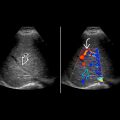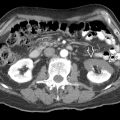TERMINOLOGY
Definitions
- •
Abdomen: Region between diaphragm and pelvis
GROSS ANATOMY
Anatomic Boundaries of Anterior Abdominal Wall
- •
Superiorly: Xiphoid process and costal cartilages of 7th-10th ribs
- •
Inferiorly: Iliac crest, iliac spine, inguinal ligament, and pubis
- •
Inguinal ligament is inferior edge of aponeurosis of external oblique muscle
Muscles of Anterior Abdominal Wall
- •
Consist of 3 flat muscles (external oblique, internal oblique, and transverse abdominal), and 1 strap-like muscle (rectus)
- •
Combination of muscles and aponeuroses (sheet-like tendons) act as corset to confine and protect abdominal viscera
- •
Linea alba is fibrous raphe stretching from xiphoid to pubis
- ○
Forms central anterior attachment for abdominal wall muscles
- ○
Formed by interlacing fibers of aponeuroses of oblique and transverse abdominal muscles
- ○
Rectus sheath also formed by these aponeuroses as they surround rectus muscle
- ○
- •
Linea semilunaris is vertical fibrous band at lateral edge of rectus sheath bilaterally
- ○
Aponeuroses of internal and transversus abdominis join in linea semilunaris before forming rectus sheath
- ○
- •
External oblique muscle
- ○
Largest and most superficial of 3 flat abdominal muscles
- ○
Origin: External surfaces of ribs 5-12
- ○
Insertion: Linea alba, iliac crest, pubis via broad aponeurosis
- ○
- •
Internal oblique muscle
- ○
Middle of 3 flat abdominal muscles
- ○
Runs at right angles to external oblique
- ○
Origin: Posterior layer of thoracolumbar fascia, iliac crest, and inguinal ligament
- ○
Insertion: Ribs 10-12 posteriorly, linea alba via broad aponeurosis, pubis
- ○
- •
Transversus abdominis (transversalis) muscle
- ○
Innermost of 3 flat abdominal muscles
- ○
Origin: Lowest 6 costal cartilages, thoracolumbar fascia, iliac crest, inguinal ligament
- ○
Insertion: Linea alba via broad aponeurosis, pubis
- ○
- •
Rectus abdominis muscle
- ○
Origin: Pubic symphysis and pubic crest
- ○
Insertion: Xiphoid process and costal cartilages 5-7
- ○
Rectus sheath: Strong, fibrous compartment that envelops each rectus muscle
- –
Contains superior and inferior epigastric vessels
- –
- ○
- •
Actions of anterior abdominal wall muscles
- ○
Support and protect abdominal viscera
- ○
Help flex and twist trunk, maintain posture
- ○
Increase intraabdominal pressure for defecation, micturition, and childbirth
- ○
Stabilize pelvis during walking, sitting up
- ○
- •
Transversalis fascia
- ○
Lies deep to abdominal wall muscles and lines entire abdominal wall
- ○
Separated from parietal peritoneum by layer of extraperitoneal fat
- ○
Muscles of Posterior Abdominal Wall
- •
Consist of psoas (major and minor), iliacus, and quadratus lumborum
- •
Psoas: Long, thick, fusiform muscle lying lateral to vertebral column
- ○
Origin: Transverse processes and bodies of vertebrae T12-L5
- ○
Insertion: Lesser trochanter of femur (passing behind inguinal ligament)
- ○
Action: Flexes thigh at hip joint; bends vertebral column laterally
- ○
- •
Iliacus: Large triangular sheet of muscle lying along lateral side of psoas
- ○
Origin: Superior part of iliac fossa
- ○
Insertion: Lesser trochanter of femur (after joining with psoas tendon)
- ○
Action: “Iliopsoas muscle” flexes thigh
- ○
- •
Quadratus lumborum: Thick sheet of muscle lying adjacent to transverse processes of lumbar vertebrae
- ○
Invested by lumbodorsal fascia
- ○
Origin: Iliac crest and transverse processes of lumbar vertebrae
- ○
Insertion: 12th rib
- ○
Actions: Stabilizes position of thorax and pelvis during respiration, walking; bends trunk to side
- ○
Paraspinal Muscles
- •
Also called erector spinae muscles
- ○
Invested by lumbodorsal fascia
- ○
- •
Composed of 3 columns
- ○
Iliocostalis: Lateral
- ○
Longissimus: Intermediate
- ○
Spinalis: Medial
- ○
- •
Origins: Sacrum, ilium, and spines of lumbar and 11th-12th thoracic vertebrae
- •
Insertions: Ribs and vertebrae with additional muscle slips joining columns at successively higher levels
- •
Action: Extends vertebral column
ANATOMY IMAGING ISSUES
Imaging Recommendations
- •
High-frequency (5-12 MHz) linear transducer for anterior abdominal wall and paraspinal muscles
- •
3-5 MHz for posterior abdominal wall muscles
- •
Supine position for examination of anterior and lateral abdominal wall
- ○
Image during Valsalva maneuver and in standing position to increase abdominal pressure and elicit hernias
- ○
Prone position for ultrasound of paraspinal muscles
- ○
- •
Compare with contralateral side to check for symmetry
- •
Panoramic/extended field-of-view techniques are very useful to demonstrate muscles and soft tissue
ANTERIOR ABDOMINAL WALL










